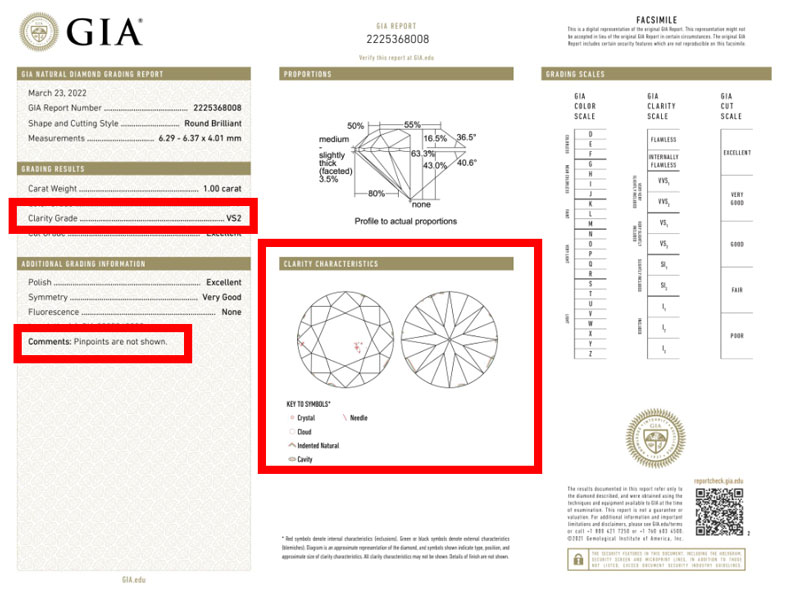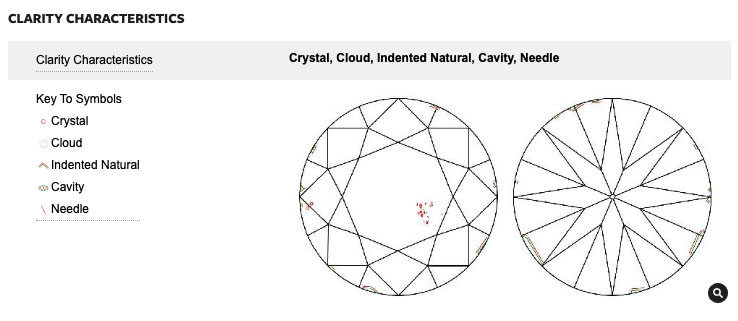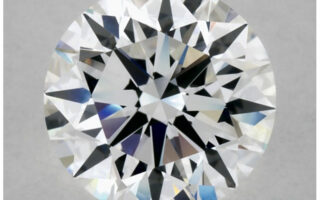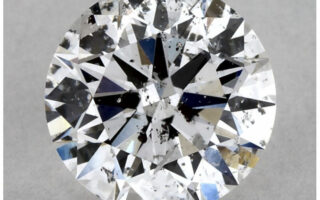Diamond Clarity Chart
Your guide to diamond clarity, with hi-def images and UK-specific pricing info
Diamond clarity is the characteristic that jewellers are often most keen to demonstrate when you are looking at diamonds, which makes it easy to get caught up in wanting to get a ring with the highest clarity quality possible.
But looking through a microscope or at the magnified images online can give you a false sense of what diamonds actually look like.
For most people, ensuring that a diamond is ‘eye clean’ should be a priority: this can mean either a VS2 or a good SI1.

The diamond clarity chart
The standard diamond clarity chart, as defined by GIA is below:

Almost all diamond grading authorities use this chart, with the exception of AGS, which has developed its own chart.
When reviewing diamonds, either online or at a jeweller, these are the terms that will be used.
What is diamond clarity?
Clarity is basically a grading on the number of imperfections that a diamond has.
The imperfections came about during the natural formation of the stone, 3 million-ish years ago. As molten rock cooled to form the crystalline structure that makes a diamond, other minerals were also present and were included in the diamond as it formed.
Sometimes also called ‘flaws’, the imperfections are technically known as ‘inclusions’ if they are inside the stone or ‘blemishes’ if they are on the outside of the stone.
What’s the best diamond clarity?
While ‘Flawless’ is the top of the diamond clarity scale, this doesn’t necessarily mean that it’s the best choice for most people.
As you’ll see in the next section, above a certain level, diamonds all look absolutely perfect once they are mounted into a ring.
Of course, if you do want to have the best of the best, then you can choose a flawless or internally flawless stone, but for most people, choosing an eye-clean VS2 or SI1 is the best balance of beauty and value for money.
Examples of diamonds at each clarity grade
The table below shows a typical example of each clarity grade. You can click each image to magnify it, or click through on each clarity to find out more about it.
One thing to note is that a 1 carat diamond is just 6.5mm wide, so inclusions that may appear significant on a magnified image are likely to be impossible to see in real life.
How diamond clarity affects price
Clarity has the second largest effect on a diamond’s price behind carat weight.
While diamond prices are always changing, we’ve taken an average of the 5 lowest prices, as at June 2022.
It’s important to note that the prices listed at those from an online retailer and significantly lower than they would be from a traditional jeweller, which can be as much as double for an identically specced diamond.
To ensure that the comparison was fair, we looked at the difference in prices between diamonds with the following characteristics:
- Round brilliant shape
- 1 carat
- Excellent cut, symmetry and polish
- H colour grade
- Med / Weak / No fluorescence
This colour and cut grade or a good starting point when beginning your diamond search to ensure you’re not over-paying for colour and that your diamond sparkles.
| Clarity grade | Cost | Difference (£) | Difference (%) |
|---|---|---|---|
| Flawless | £11,200 | ||
| Internally Flawless | £8,200 | £3,000 | 26.8% |
| VVS1 | £7,600 | £3,600 | 32.1% |
| VVS2 | £7,400 | £3,800 | 33.9% |
| VS1 | £6,800 | £4,400 | 39.3% |
| VS2 | £6,600 | £4,600 | 41.1% |
| SI1 | £5,340 | £5,860 | 52.3% |
| SI2 | £4,100 | £7,100 | 63.4% |
As you can see, there is a drastic drop from ‘flawless’ to ‘internally flawless’ due to the rarity of truly flawless diamonds.
Prices continue to drop at each grade, with VS1 and VS2 diamonds being around 40% less expensive than flawless stones. VS is a good clarity grade to begin your search with, and it may also be worth reviewing SI1 diamonds to see whether you can find an eye-clean stone that fits your other criteria.
Diamond clarity on a grading report
We recommend that you only consider diamonds that are accompanied by an independent grading report, to ensure that you are actually buying a diamond of the quality you are paying for.
When you are considering a diamond, you can request to see an electronic copy of a grading report, or you can ask for a grading report number that you can check on the grading labs online system. The GIA’s report check is here.
There are three places that incude clarity information on a grading report.
- The first is the clarity grade is listed in the ‘grading results’ section.
- Then there is a map of the ‘clarity characteristics’ which shows the type and location of the inclusions
- Lastly there is the ‘comments’ section, which includes information on any inclusions which aren’t shown in the clarity characteristics map. Usually this is nothing to worry about, but if a diamond is SI1 or SI2 and the comment ‘clarity grade based on clouds not shown’, this can mean that the diamond is negatively impacted by a large number of small inclusions which are likely to reduce the amount of light it transmits, and should probably be avoided.

The clarity chart is extremely useful in understanding where you should look when assessing a diamond.
With this diamond, we can see that there is a collection of small crystals in the lower right of the ‘table’ – the flat area on top of the diamond:

If we look at this actual diamond (below, but rotated slightly from the clarity chart), we can see that the inclusions are actually very small and won’t be visible to the naked eye:

The flipside of this is that some diamonds are given low clarity grades because of inclusions near the edge of the stone. If this is the case, the inclusion could possibly be covered by a prong of the ring setting, which would mean that it would look perfectly eye clean.
Diamond clarity and pictures online
If you’re considering buying a diamond online, it’s important to be able to see the actual diamond that you are evaluating.
Many jewellers use stock pictures, which don’t necessarily reflect what the diamond will actually look like.
If you are considering a VS2 diamond or below, it’s essential to view images, or ideally video, of the exact diamond you are reviewing.
A good example is this ring from Mappin & Webb – a 0.7 carat solitaire priced at a not insignificant £5,000:

Mappin and Webb even let you zoom in on the diamond itself:

It looks nice and clear, with no visible inclusions or flaws.
However if we look at the diamond quality characteristics, we can see that this diamond is in fact specced with an I1 clarity diamond.
An I1 clarity diamond could look like this:

Very different from the Mappin & Webb image!
Aside from the fact that this ring is hugely overpriced (a 0.7 carat with acceptable stats of excellent cut, H colour, VS2 clarity is around £3,500), if you did order the ring from Mappin & Webb, you would likely be very disappointed.
Final tips on diamond clarity:
- Aim for eye-clean – anything else is overpaying and this is budget that you could spend on other attributes (better cut grade or higher carat weight).
- Always check the clarity map on the grading report, which will show you where to look.
- If you are looking at VS2 diamonds or below, you must see images of the actual stone you are considering.
- Be wary of ‘clouds’, which aren’t always noticeable on images, but which can significantly reduce the amount of light the diamond allows to pass through.












